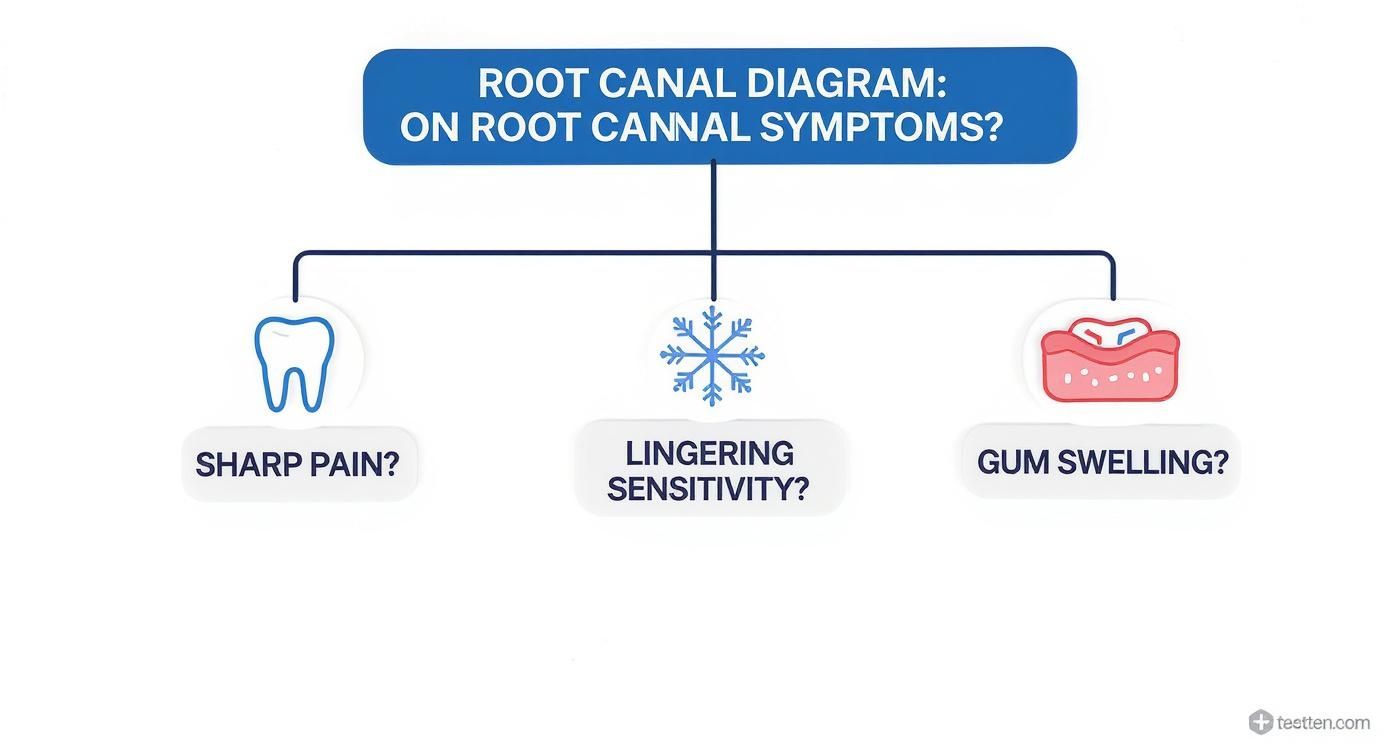How to Know If You Need a Root Canal: Your Actionable Guide
- Caterina Rutter
- Nov 17
- 10 min read
If you're asking, "how to know if you need a root canal," your body is likely sending you clear signals. The key is to know what to do about them. Look for severe, nagging tooth pain that won't quit, sensitivity to hot or cold that sticks around, and gums that are swollen or tender.
Think of these signs as your tooth's built-in alarm system. Your next step is to figure out how urgently you need to act.
Reading the Signs: What to Do When Your Tooth Is in Trouble
Imagine your tooth has a tiny, hollow space at its core. This area, called the pulp, is filled with nerves and blood vessels. When it gets infected or inflamed—whether from a deep cavity, a crack, or an old injury—your body sounds the alarm. Acting on these early warnings is the key to saving your natural tooth and avoiding more complex procedures.
The pain from an infected tooth isn't a minor annoyance. It’s often a deep, throbbing ache that over-the-counter pills can't touch and might even wake you up at night. This is a direct signal that the inflammation is pressing on the nerve inside your tooth.
The Most Common Red Flags to Act On
While only a dentist can give you a definitive diagnosis, knowing these signs helps you understand when to seek immediate care.
Here are the classic indicators that your tooth's pulp is in distress and what they mean for you:
Sensitivity That Lingers: If pain from hot coffee or ice cream lasts for 30 seconds or more, it’s time to call the dentist. This signals the nerve is damaged and likely won't heal on its own.
Sharp Pain When You Bite Down: A focused, sharp pain when chewing is not normal. Schedule a dental visit, as this often points to an infection at the root's tip that needs treatment.
Swollen or Tender Gums: A small, pimple-like bump (an abscess) on your gums is a sign of a serious infection. This requires urgent dental care to prevent it from spreading.
A Darkened Tooth: If a tooth starts to look grayish or discolored, it means the pulp inside has likely died. Make an appointment to have it checked, as the dead tissue can harbor bacteria.
This infographic is a great visual guide for connecting your symptoms to what you should do next.

As you can see, persistent pain, lasting sensitivity, and swollen gums are all direct paths to scheduling a dental visit.
Symptom Severity Checklist: When to Call Your Dentist
Use this table to quickly assess your symptoms and determine your next step. This is your personal action plan for tooth pain.
Symptom | What It Feels Like | Action to Take |
|---|---|---|
Lingering Sensitivity | A sharp ache from hot or cold that lasts more than 30 seconds. | Call your dentist soon. This indicates nerve inflammation that needs to be evaluated. |
Severe, Constant Pain | A deep, throbbing pain that disrupts sleep and isn't helped by painkillers. | Call your dentist immediately. This is a sign of a significant infection that requires prompt action. |
Gum Swelling or Bump | A tender, swollen area on the gum or a small, pimple-like abscess. | Seek urgent dental care. An abscess won't go away on its own and can lead to serious complications. |
Pain When Biting | A sharp, localized pain when you chew or apply pressure. | Schedule a dental visit. Let your dentist diagnose the source of the pain before it worsens. |
Tooth Discoloration | Your tooth has turned a grayish or dark color. | See your dentist. Even without pain, a discolored tooth needs to be examined for internal damage. |
This checklist isn't a substitute for professional advice, but it provides clear, actionable steps. When in doubt, call your dentist.
What a Root Canal Actually Does
The term "root canal" often causes unnecessary anxiety. The reality is that a root canal is a restorative treatment with a clear goal: to save your natural tooth and stop your pain. It’s not a major operation; it's a precision deep-cleaning for the inside of your tooth.

Think of it this way: if you get a deep splinter in your finger, you don't amputate the finger. You carefully remove the splinter so the area can heal. A root canal applies the same logic to your tooth.
Rescuing Your Tooth from the Inside Out
Deep inside every tooth is a soft core called the pulp, containing nerves and blood vessels. When a deep cavity, crack, or injury allows bacteria to enter, this pulp gets infected. That’s what causes the intense, throbbing pain signaling that a root canal may be necessary.
The procedure itself is surprisingly straightforward. A dentist or a root canal specialist (an endodontist) simply:
Removes the infected and inflamed pulp tissue.
Carefully cleans and disinfects the now-empty inner chamber.
Fills and seals the space to block out any future bacteria.
The goal isn’t to remove the tooth’s roots. It’s to clear out the infection within the roots. This process eliminates the source of the pain and, just as importantly, stops the infection from spreading into your jawbone.
With modern techniques and effective anesthetics, the procedure itself is typically no more uncomfortable than getting a standard filling. By removing the inflamed nerve, the treatment actually brings immediate relief. It's a highly successful procedure that lets millions of people keep their natural teeth every year, avoiding extractions and more involved replacements like dental implants or bridges.
Decoding the Signs Your Tooth Is in Trouble

Knowing if you need a root canal starts with listening to your body. These signals tell you something is wrong deep inside your tooth. Your job is to act on them.
The most classic and unmistakable sign is a severe, throbbing toothache. We’re not talking about a minor twinge—this is pain that disrupts your focus during the day and keeps you up at night. This intense ache is caused by pressure building up inside the tooth's pulp chamber. It's your body's emergency alert system, and it requires professional attention.
Sensitivity That Overstays Its Welcome
Another major red flag is sensitivity that won't quit. A brief "zing" from ice water is common. But when that sharp pain hangs around for more than 30 seconds, it’s a sign that the nerve is too damaged to handle temperature changes properly.
This prolonged reaction is a clear indicator of deep irritation. If you've been dealing with this, our guide on what causes tooth sensitivity to cold and how to stop it can offer more insight.
The key difference isn't the initial shock of pain—it's how long it lasts. A healthy tooth recovers almost instantly. A tooth in trouble keeps hurting long after the cold or heat is gone.
According to the American Association of Endodontists, this lasting sensitivity is one of the most frequent reasons people need a root canal. It's a telltale symptom that endodontists see daily, and your cue to make a dental appointment.
Visual and Physical Clues You Cannot Ignore
Pain is a powerful messenger, but it's not the only one. Sometimes, the most important clues are ones you can see or feel. Pay close attention to the tooth itself and the gums surrounding it.
Here are other critical warning signs to watch for:
Swollen Gums: If the gums near one tooth are puffy, red, or tender, it’s often a sign of infection spilling out from the tooth's root. Don't ignore this.
A "Pimple" on the Gums: A small, persistent bump on your gum line (a fistula or abscess) is a sure sign of infection. It's the body's attempt to drain pus from the root tip. This needs to be treated by a dentist.
A Darkening Tooth: Has one of your teeth turned grayish or dark? This often means the pulp inside has died. The dead tissue needs to be removed before it causes further issues.
Pain When Chewing: If it hurts to bite down or even just tap on a specific tooth, it usually points to an abscess at the root's tip. The ligament holding the tooth is inflamed and requires treatment.
Recognizing these clues early gives you the power to get a professional diagnosis before the problem escalates.
So, What Puts a Tooth in Root Canal Territory?
To understand whether you might need a root canal, it helps to know what goes wrong in the first place. Think of your tooth’s hard outer layers—enamel and dentin—as armor. A root canal becomes necessary when something breaks that armor, letting bacteria attack the soft pulp inside.
The most common culprit is deep tooth decay. An ignored cavity burrows deeper until it hits the pulp, creating a direct pipeline for infection. This is why your dentist emphasizes regular check-ups: to catch and fill cavities long before they reach this stage, saving you from pain and more extensive treatment.
Other Ways the Pulp Can Get Hurt
While a bad cavity is the usual suspect, other issues can also put your tooth at risk.
Cracks and Chips: A deep crack or chip can be as bad as a cavity, giving bacteria a shortcut straight to the pulp.
A Hard Knock: A sports injury or accident can damage or kill the pulp, even without an obvious crack. Damage from an old injury can sometimes take years to surface.
Too Much Wear and Tear: A tooth that has had multiple fillings can eventually become stressed, causing the pulp to become inflamed and die.
Once you understand what causes the damage, it changes how you think about it. It’s not just about fixing pain; it's about preventing it. Protecting your teeth from decay and injury is the best defense against ever needing a root canal.
Untreated cavities are a massive global problem, leading to root canals for around 2.4 billion people. This is worsened because an estimated 3.5 billion people lack access to affordable dental care to stop decay early. If you're interested in the numbers, you can explore global dental health trends on Coherent Market Insights.
How a Dentist Confirms You Need a Root Canal
Walking into a dental office with a toothache can be nerve-wracking, but understanding the diagnostic process can reduce anxiety. When your dentist suspects a root canal is necessary, they follow a methodical, evidence-based process to confirm it's the right course of action.

The evaluation starts with a visual check of the tooth and gums for swelling, discoloration, or an abscess. From there, your dentist will run a few quick, painless tests to assess your tooth's health.
Diagnostic Steps in the Dental Chair
To determine what's happening inside your tooth, your dentist will use a few key tests. Each provides a different piece of the puzzle.
You can expect these diagnostic steps:
Percussion Test: The dentist gently taps on your tooth. Pain upon tapping is a sign that the ligament around the root is inflamed—a classic symptom of infection.
Cold Test: A cold cotton pellet is touched to the tooth. A healthy tooth feels a sharp cold that fades immediately. If the ache lingers intensely, it signals the nerve is seriously irritated and likely requires treatment.
Bite Test: You'll bite down on a small plastic stick. A sharp pain when you bite helps pinpoint a crack or an issue at the tip of the root.
The purpose of these tests is to check the tooth's nerve vitality. Think of it like a reflex test. A healthy nerve reacts predictably and recovers quickly, while a damaged nerve will overreact, underreact, or not react at all.
Finally, the most conclusive piece of evidence comes from a dental X-ray. It's the only way to see what's happening below the gum line, revealing problems like deep decay, bone loss, or an abscess that are otherwise invisible. You can learn more about the critical role of a dental X-ray in Tempe in ensuring an accurate diagnosis.
The Real Risks of Ignoring Tooth Pain
It's tempting to hope a toothache will go away on its own, but this is a gamble you don't want to take. Tooth pain almost always signals a deeper issue that will only get worse if you ignore it.
An untreated infection will spread from the tooth's root into your jawbone, often leading to a dental abscess—a painful, pus-filled pocket that can cause facial swelling and a miserable, throbbing sensation. An abscess is a serious condition and one of the most common dental emergencies in Tempe.
From Tooth Problem to Health Problem
The danger doesn't stop at your jaw. In rare but serious situations, bacteria from an abscess can enter your bloodstream, causing a body-wide infection called sepsis. This can turn a tooth problem into a major medical emergency.
On top of that, waiting is the fastest way to lose the tooth for good.
A root canal is ultimately a tooth-saving procedure. Putting it off allows the decay and infection to do so much damage that the tooth simply can't be repaired, making extraction the only choice left.
This is why acting on symptoms early is so important. The global market for these treatments is projected to hit nearly USD 2.80 billion by 2032, largely because more people understand that quick action saves teeth. You can read more about these endodontic market trends on GlobeNewswire. Making a timely decision doesn't just protect your tooth—it protects your overall health.
Common Questions About Root Canal Treatment
Even when you know the signs, it's normal to have questions. Getting clear answers about the process can help you feel confident in your decision.
The most common question is, "Will it hurt?" Let's clear this up: thanks to modern anesthetics and refined techniques, getting a root canal today is typically no more uncomfortable than a simple filling. The purpose of the treatment is to relieve the intense pain of the infection, not cause more.
Understanding the Logistics and Alternatives
People also want to know what to expect in terms of time and other options. Getting these details helps you prepare for the appointment and recovery.
Here are answers to the most common questions:
How long does it take? A root canal is usually finished in one or two visits, with each appointment lasting about 90 minutes, depending on the tooth.
What are the alternatives? The only alternative is to extract the tooth. While sometimes necessary, saving your natural tooth is almost always the best option to keep your bite aligned and prevent other teeth from shifting.
What is recovery like? You’ll be numb for a few hours afterward. Mild soreness for a day or two is normal and easily managed with over-the-counter pain medication. Most people return to their normal routine the next day.
A root canal isn’t about losing a tooth—it’s a highly successful procedure designed to save it. By removing the infection from the inside, we're not just protecting the tooth, but your overall health, too.
At Beautiful Dentistry, we make your comfort our top priority and believe in giving you clear, honest answers. If tooth pain is disrupting your life, schedule a comprehensive exam and X-rays with us today to get the relief you deserve. Learn more and book your appointment at https://zdentist.com.


Comments